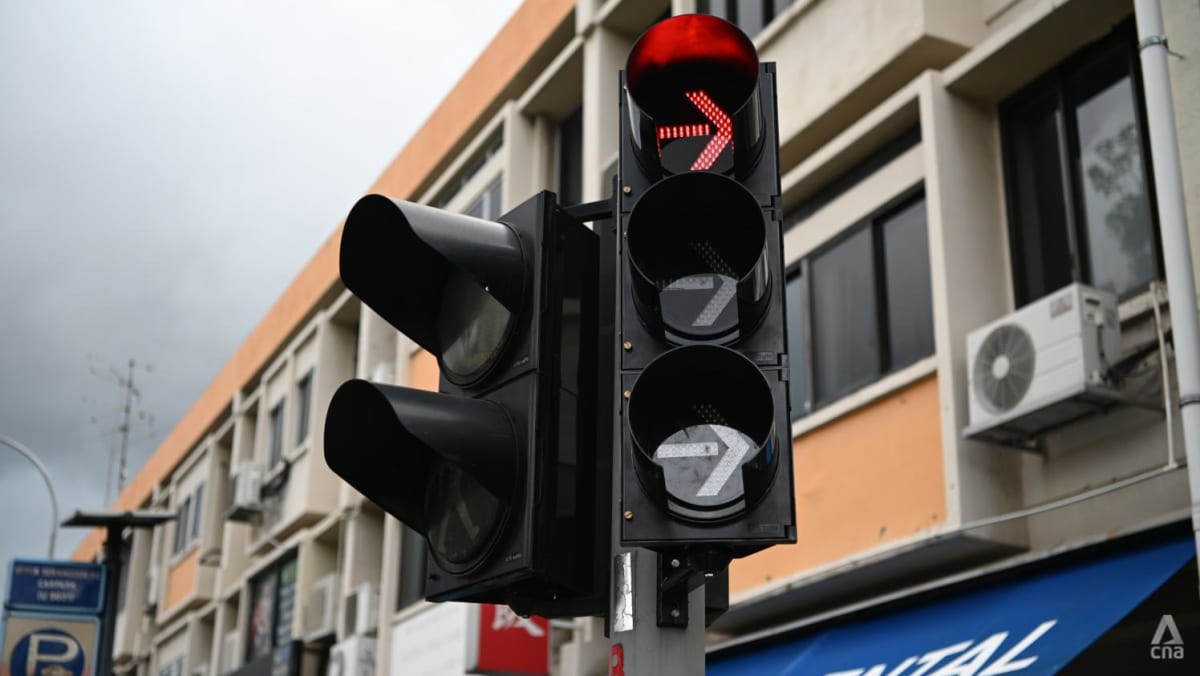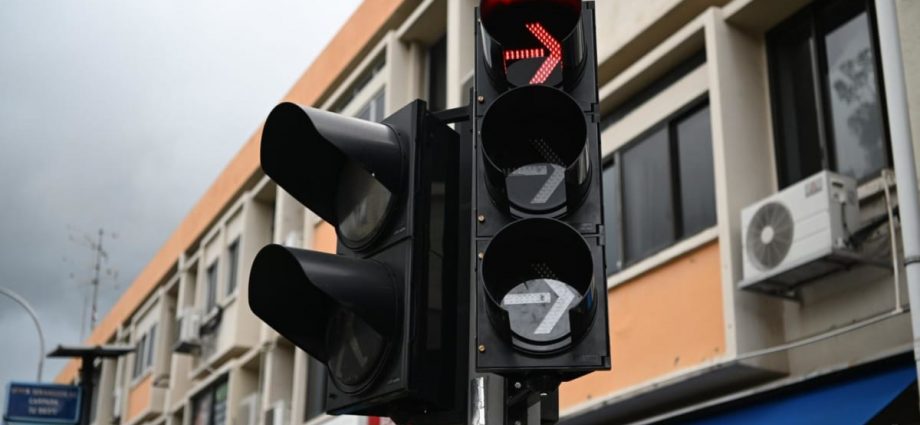
WHAT MAKES A JUNCTION UNSUITABLE
Major junctions are generally “not a problem”, as the centre median strip that divides the road would be able to support the pair of traffic lights: The standard traffic light and the new red-amber-green arrow light.
“As a best practice, we will definitely try to put a pair (of lights) on the centre median. But sometimes we can’t due to site constraints, especially at older roads or junctions, where we just can’t install anything on the median. That’s a bit challenging,” said Mr Png.
“Or some medians are too narrow; you can’t widen it further (due to site constraints) to accommodate that extra red-amber-green traffic light.”
Narrow junctions or junctions with “a single lane or limited lanes” also pose an issue, “especially if it’s a busy junction”, he noted.
“At red-amber-green junctions, you’re not allowed to turn right even if there is no opposing traffic or pedestrians crossing. So if the lanes are limited, right-turning traffic waiting to turn right would obstruct the through traffic,” he explained.
If such a junction is considered “unsafe”, yet the road can’t be widened or have more lanes added, the traffic light sequence might need to be changed, added Mr Png.
“You might have to give that approach a dedicated green time, so both through and right-turning traffic can go at the same time. But that will also result in trade-offs in terms of delays to other approaches.”
Another possible solution is an “overhead” red-amber-green arrow, which LTA has currently implemented at some such junctions.
“What we do is modify the red-amber-green arrow at those locations, so that the overhead red-amber-green traffic lights are horizontal instead of vertical. This eliminates any civil works on the centre median which then reduces burden on contractors and disruption to traffic,” he said.
Existing roads with overhead red-amber-green arrows include the junctions of Bishan Street 13 and Street 14, Bencoolen Street and Middle Road, and Jurong East Avenue 1 and Street 21.
REDESIGNING ONE JUNCTION AFFECTS OVERALL TRAFFIC
Nonetheless, Mr Png acknowledged that once a discretionary right-turn junction gets a red-amber-green arrow, there will be “some trade-offs” and “mitigation measures” may have to be introduced.
“It could be something as simple as changing the phasing or the sequence of traffic lights. It could go even further where civil works are necessary,” he said.
“We look at what’s the most optimum design. Because with every change, there are multiple variables which change. Everything is related to everything else. It’s an iterative process; you have to run the simulation, change the design, run the simulation (again), then come to a steady state of optimisation.”
The entire process could take a couple of months with civil works, especially where there is a need to do trenching of underground pipes in order to lay new cables.
“It all depends on whether there are enough cables, because if not, you might have to dig a trench to lay pipes, pull the new cables and then connect to the controller. But if the junction has enough cables, then certainly it’s faster,” he added.
Drawing on an analogy to explain how the team manages the trade-offs involved during the design process, Mr Png likened a traffic light cycle to a pie from which motorists and pedestrians fight for a slice. This slice represents the amount of time one has to navigate through the junction.
A traffic light cycle is the total time required for the light to serve all signal phases.
“The trade-off for red-amber-green arrows is delays. The slice of the time is more (with a red-amber-green arrow), changing the proportion of the other slices of the pie,” he said.
“If one person is asking for more time, I need to give a bigger slice of the pie and that could be at the expense of another person. It could be the pedestrian or it could be traffic in the opposite direction that’s in conflict. If you increase one portion, you decrease another portion.”
And if everyone needs more time, the overall size of the pie increases. If the increase is “too much”, then the waiting time at the junction becomes longer. This would then affect the next junction as it would also need to run with the same traffic cycle, because “it’s all synchronised”, he added.
“In order to achieve synchronisation, every junction must have the same (corresponding) size of pie throughout the entire road corridor downstream. As a road user, they will then feel frustrated if they sense that they are waiting longer than necessary.”
That said, motorists waiting for the green arrow during the wee hours, for instance, would experience a shorter waiting time than if they were at the same junction during peak hours.
Singapore’s roads have dynamic traffic phasing due to the Green Link Determining (GLIDE) system, which adjusts the green time as traffic flow changes.
With GLIDE, loop detectors embedded in the road lanes are used to detect the presence and intensity of vehicle and pedestrian traffic, triggering traffic signal adjustments.
“With off-peak hours, like wee hours of the night, your slices of the pie can be smaller because there is lesser demand for time at the junction, hence the (total) cycle time is smaller. That reduces the frustration of waiting,” explained Mr Png.
“We’ve also introduced repeated right turns at some junctions – within the cycle time that you have, two opportunities to turn right. And if there’s no traffic for an approach, then I could give that slice of time to another approach that needs it.”
With motorists at these redesigned junctions forbidden from making discretionary right turns, however, Mr Png hopes that pedestrians don’t take their safety for granted and pay less attention when crossing the junction.
He cautioned that “mistakes can still happen” despite the red-amber-green arrow, which is not a silver bullet to eradicating traffic accidents.
“The entire driving experience from your home or car park to your destination is a discretionary activity, not just the right turn,” he added.
“Whether you look out for traffic, or decide to turn right or left when you come out of the car park, switching lanes, every time is a discretionary decision.”

